Samsung Electronics’ The Premiere is back and more powerful than ever, after revolutionizing the premium projector market with its 2020 debut. Apart from its celebrated home cinema capabilities, The Premiere lineup has been enhanced with an array of new lifestyle features to broaden functionality beyond mere video viewing.
Samsung Newsroom met with developers Jaeyoung Park, Seonbin Jang and Jonguk Shin from the Visual Display Business at Samsung Electronics to discuss The Premiere’s new features and next steps for the projector.

▲ (From left) Jaeyoung Park, Seonbin Jang and Jonguk Shin
Ultra-Short Throw: Embracing a New Era of Home Cinema
Within a year of its launch in 2020, The Premiere ascended to the top of the premium projector market in North America — achieving this feat by delivering an unparalleled home cinema experience to users.
The true value of The Premiere’s home cinema features became evident during the COVID-19 pandemic. As more people stayed at home, the online streaming industry expanded and brought projectors into the spotlight. The ultra-short throw projector segment, a category that includes The Premiere, represented just 7.2%1 of the premium home cinema projector market in 2019. However, following the pandemic, this share grew to 22.5% by 2023.
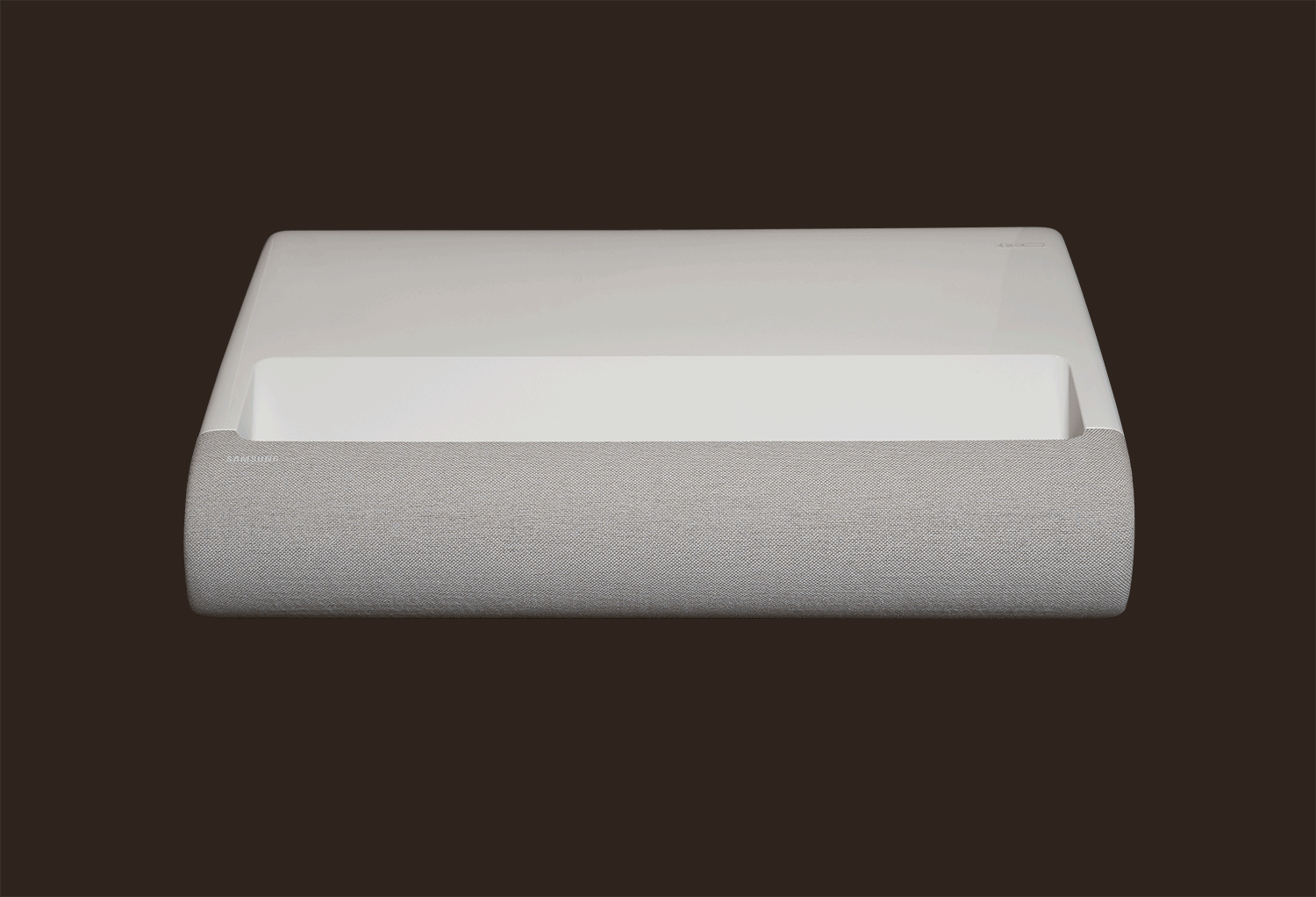
▲ The Premiere 9
The Premiere’s biggest advantage lies in its convenience. Utilizing ultra-short throw technology with an aspherical mirror, the projector eliminates the need for ceiling mounts or a separate shelf to achieve an optimal projection distance. Users can simply place The Premiere directly in front of the desired wall, much like a TV, and screen adjustments can be made effortlessly via a remote control or mobile device. The Premiere 9 and The Premiere 7 are ideal for creating a personal movie theater, offering immersive screen sizes of up to 130 and 120 inches, respectively.
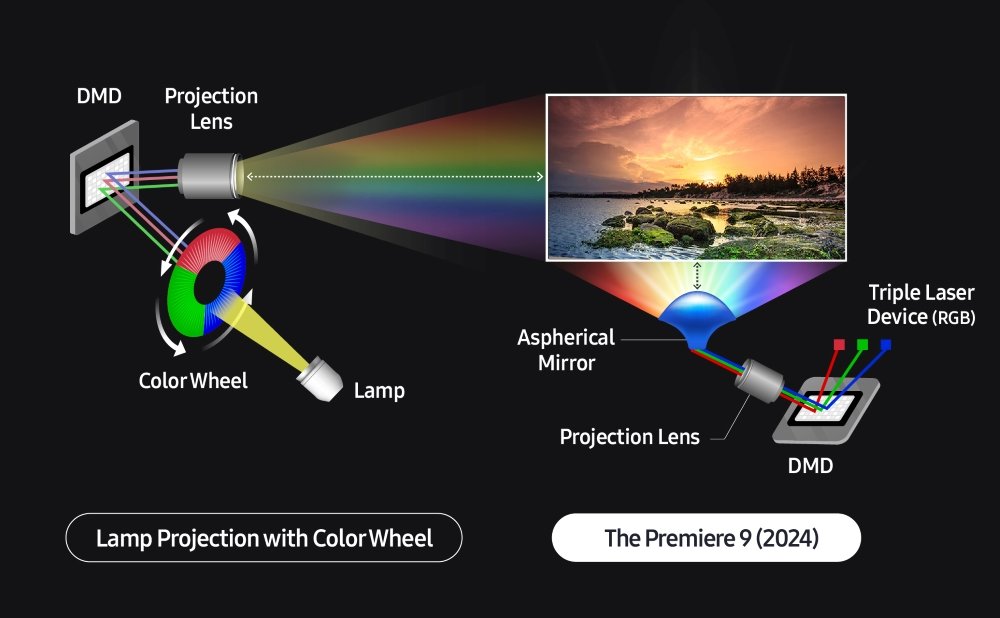
Color Wheel: Rotates rapidly in sync with the video signal to ensure images display the correct colors. Typically features 3 to 8 color sections.
Digital Micromirror Device (DMD): Precisely adjusts millions of tiny mirrors mounted on a microchip according to the video signal. This part is crucial in creating high image quality and resolution on projectors.
Triple Laser Technology: Fires lasers of the three primary colors of light — red, green and blue — to produce bright, sharp images. Contributes to brighter projections by reducing light loss in steps such as the color wheel.
Aspherical Mirror: Allows for ultra-short throw projection. Following numerous simulations, Samsung engineers came up with the optimal curvature and applied it to the new The Premiere projector.
▲ A simplified conceptualization of two major Digital Light Processing (DLP) beam projector types
“The remarkable thing about ultra-short throw projectors is their ability to create a large screen with minimal space between the device and wall,” said Shin, who led development for The Premiere. “The Premiere 9, for instance, creates a 100-inch screen with just 9.4 inches of space between the wall and device.”
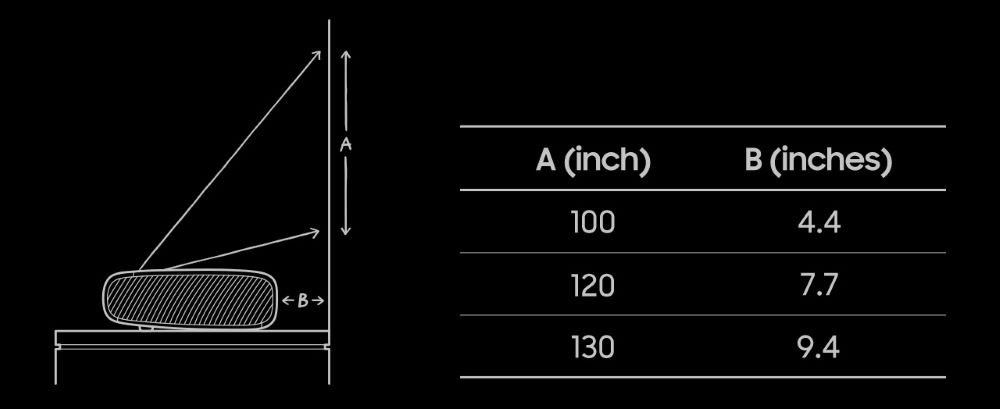
▲ The Premiere 9 can project screens up to 130 inches. (Note: Screen sizes in column A measured diagonally, not vertically)
“Home cinema projectors are all about delivering the best possible screen experience within a given space.”
– Jonguk Shin, Visual Display Business, Samsung Electronics
Upgrading With a Focus on Lifestyle
Following a successful debut, the team wanted more. They were resolute in transforming The Premiere into a comprehensive lifestyle product with value extending beyond home cinema.
“Our goal was to offer a wider range of use for The Premiere users,” explained Jang, who led product planning for The Premiere.
▲ Customize your space and set the right mood by projecting photos, color effects, background scenes and themes on your wall with The Premiere.
![]()
Custom Ambient, one of the newly added features, allows users to freely edit photos and videos through the SmartThings app on their smartphone and project them onto the wall. Users can even place widgets like a real-time clock onto the wall for everyday décor or use an animated effect like waves to make a splash during a party.
“Custom Ambient draws inspiration from The Freestyle’s Ambient Mode which is frequently used to upload social media posts,” he continued. “With The Premiere, users can create their own personalized space, even when they’re not watching videos.”
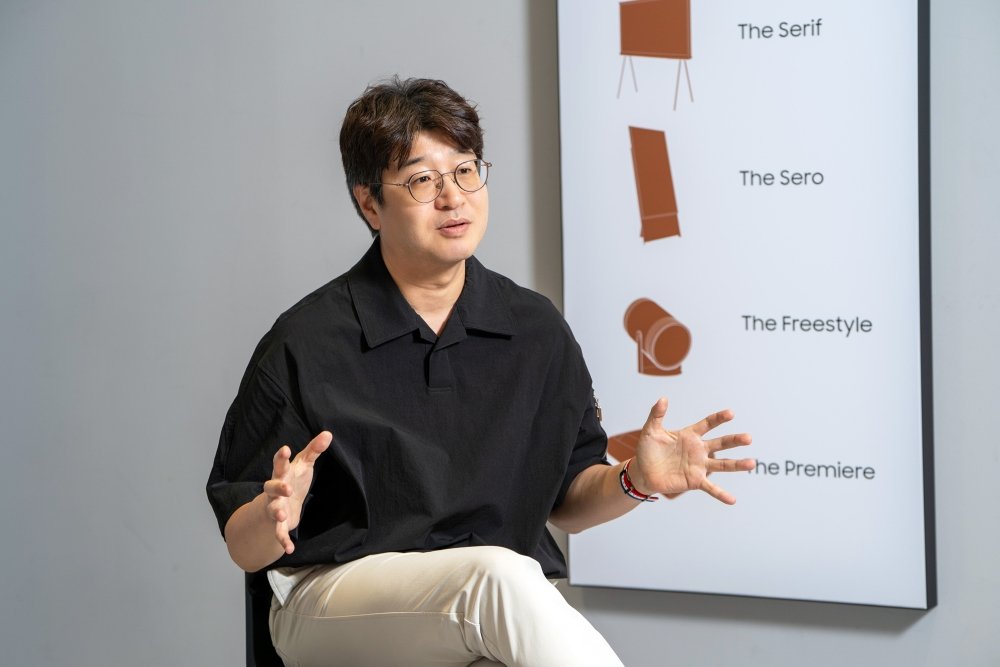
▲ Jaeyoung Park discusses The Premiere’s new lifestyle features of The Premiere.
Now with Samsung Gaming Hub installed, the projector’s entertainment capabilities have been significantly enhanced. Users can enjoy games from the cloud on the big screen without connecting a PC or gaming console. Of course, there are also plenty of HDMI slots (three) for those who want to connect PCs or gaming consoles, too.
“I often play racing games with my kids at home, and The Premiere’s 100-inch screen is perfect for the four of us to play on via split-screen without feeling cramped,” said Park.
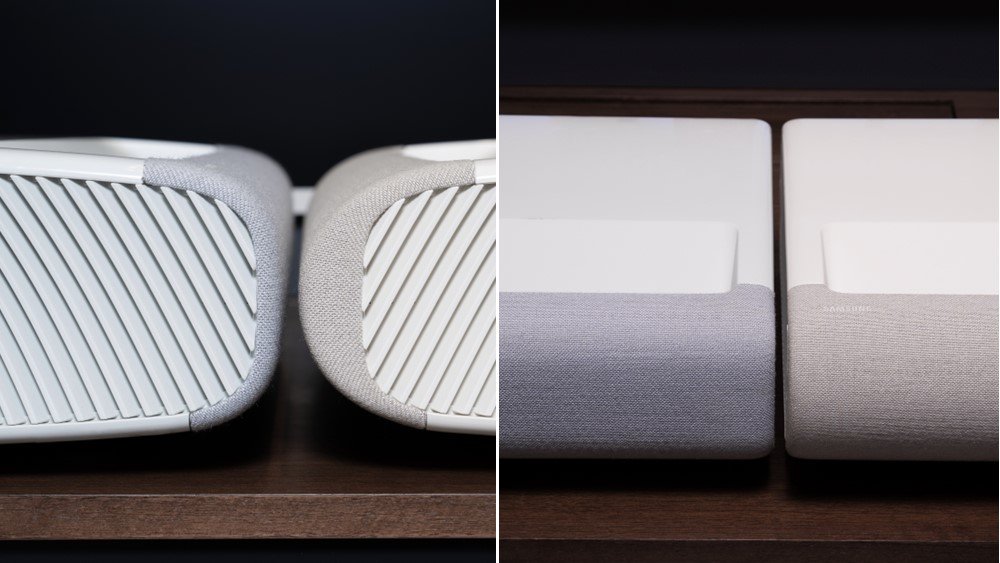
▲ There are notable aesthetic differences between the first (left in each picture) and new (right) versions of The Premiere. The 2024 version features a more compact front with a warmer shade of Kvadrat fabric to better match home décor.
When turned off, The Premiere can also function as a smart speaker.
“The Premiere 9 features a built-in 40W 2.2.2 channel up-firing speaker that delivers powerful sound,” he added. “The Premiere 9 features front-firing units like a soundbar along with ample space for audio to resonate for deeper, richer acoustics compared to other form factors. Bixby can help users to enjoy immersive audio without turning on the screen with voice commands to stream music or launch podcast apps.”
Brighter With Advanced Laser Technology
Unlike TVs in which users view light directly from the panel, projectors reflect light off the projection surface. As a result, the right components and software technology are necessary to achieving high image quality. Advanced laser technology also contributes to The Premiere’s large crystal-clear screen. The Premiere 9 utilizes triple laser technology, leveraging laser light sources from the three primary colors red, green and blue. In contrast, The Premiere 7 employs single laser technology with a blue light source, supporting a wider color gamut and higher color accuracy compared to lamp-based or LED projectors.
The Premiere 9 and The Premiere 7 deliver up to 154% and 100% of the DCI-P32 color gamut, respectively, and both models support HDR10+ to ensure crisp, vibrant images even in bright environments.

▲ The Premiere 9 features triple laser technology for brighter, sharper images.
Another key strength of The Premiere lineup is the abundant brightness offered.
“The Premiere 9 delivers a peak brightness of up to 3,450 ISO lumens3 with triple laser technology, while The Premiere 7 offers up to 2,500 ISO lumens with single laser technology,” said Shin. “The higher maximum brightness provides clearer picture quality and a more comfortable viewing experience compared to previous models. The laser light source also boasts a long lifespan and consumes less power than traditional lamp-based projectors. In other words, maintenance costs may actually be lower.”
Smarter, AI-Powered Home Cinema
Despite its numerous usability features, the essence of The Premiere remains centered on watching videos.
“In an internal survey of The Premiere users, 90% of respondents indicated that they purchased the device to watch movies,” said Jang.
“Samsung’s robust hardware and AI technology, long recognized as No. 1 in TVs, have enhanced the picture and sound quality of The Premiere.”
– Jaeyoung Park, Visual Display Business, Samsung Electronics
To deliver a premium home cinema experience, the developers focused on elevating picture and sound quality. Automation through AI technology was key. With 4K AI Upscaling, The Premiere delivers vibrant 4K resolution and significant improvements in picture quality. The Vision Booster leverages a light sensor to automatically detect and adjust ambient brightness in real time and calibrate color and contrast using an algorithm for optimal picture quality.
“The Premiere is smarter than ever before,” said Park. “Samsung’s robust hardware and AI technology, long recognized as No. 1 in TVs, have enhanced the picture and sound quality of The Premiere.”

▲ Jonguk Shin explains the advantages of ultra-short throw technology.
While Samsung has retained the acclaimed built-in speakers from The Premiere’s predecessor, the 2024 lineup has introduced a variety of new AI features for audio as well. In addition to Dolby Atmos technology, an essential for immersive movie-watching, several AI-driven sound technologies have been incorporated including:
- Active Voice Amplifier (AVA) Pro, a feature that distinguishes voices from ambient noise and adjusts the voice volume accordingly.
- Object Tracking Sound (OTS), a feature that synchronizes sound with movements on screen.
- Adaptive Sound, a feature that automatically optimizes audio based on the surrounding environment.
Additionally, Q-Symphony allows users to connect wireless speakers for a more holistic listening experience.
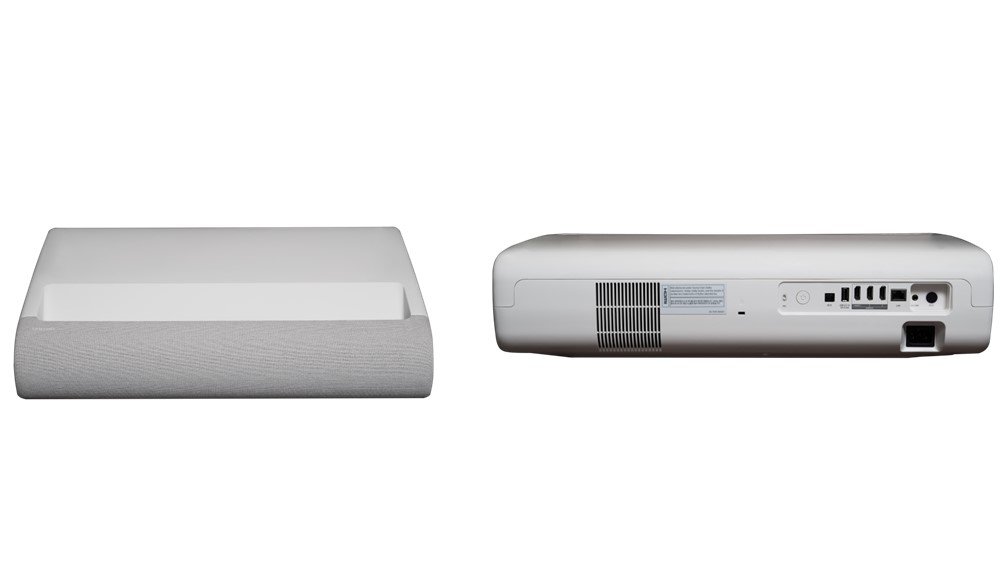
▲ The Premiere projectors feature a minimalist, warm white design with rounded edges and a premium fabric finish from Kvadrat, a Danish textile design company that seamlessly blends in with any home decor. In the back, there is a Digital Audio Out (Optical) port and three HDMI ports, a LAN port as well as ex-Link and IR ports for better remote control
Transcending the Limits of Space for Immersion
What started as a movie projector for theaters, the modern projector has thrived due to its unique ability to transcend space — overcoming the physical constraints of screen size and location. Now, the advent of ultra-short throw technology has significantly mitigated the issues of space and passer-by shadows traditionally associated with beam projectors.
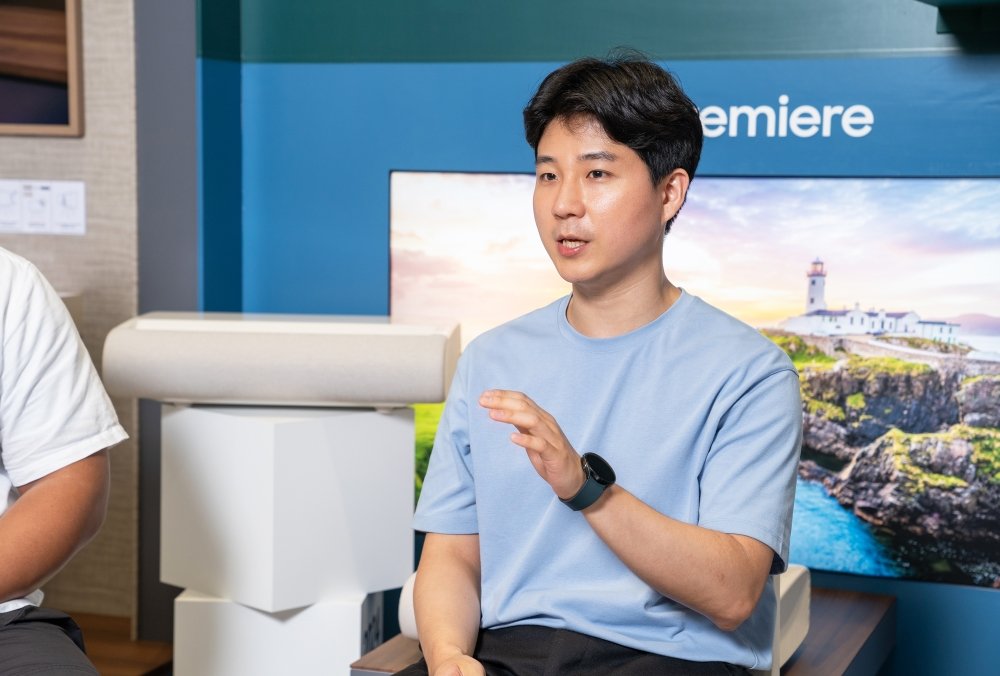
▲ Seonbin Jang describes the appeal of projectors.
As The Premiere continues to lead the way in the premium home projector market, what is next for this innovative device?
“Our goal is to seamlessly integrate projector screens to more spaces, such as walls and ceilings in homes,” said Park.
“The unique beauty of projectors is their ability to project beyond the physical confines of frame,” Jang reiterated. “In the future, we hope to evolve this into a spatial display that transcends the limitations of projection space — ultimately achieving a truly immersive screen experience, everywhere and anywhere.”
“Home cinema projectors are all about delivering the best possible screen experience within a given space,” concluded Shin. “We are committed to overcoming physical constraints to maximize the consumer experience.”
1 Mainstream & High-end Home Cinema category, excluding China, based on revenue.
2 The Digital Cinema Initiatives (DCI) standard color gamut
3 Brightness level based on the International Organization for Standardization (ISO)
This article was first published at Source link . You can check them out for other stuffs
